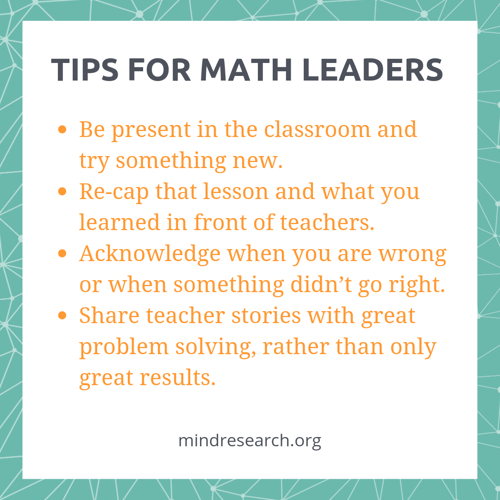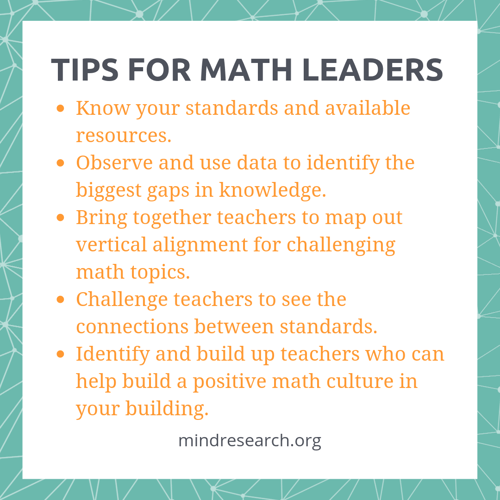
“So, you’re a math leader. Now what?”
This was the title of an illuminating session I attended at the Conference for the Advancement of Mathematics Teaching (CAMT) this past summer. Lead by Mariana Breaux (@MarianaBreaux) and Selena Contreras (@SelContreras811), these two math leaders from Pasadena ISD shared their insights and takeaways from the process of becoming math leaders in their buildings. There were a surprising number of teachers in the audience who were not math coaches or grade-level leaders per se.
That leads me to believe that there’s an increasing need for more math leaders, both formally and informally.
So, we asked teachers, math coaches, and principals from around the world, what makes a great math leader? We hope this compilation of tips and resources helps you wherever you are in your journey to support math education for students.
I think being a great math leader is being honest about your own math struggles growing up.
- Melanie Cooper, STREAM Teacher, Freeport Elementary School, Brazosport ISD TX
I ditto that, but also realizing I still do not know some of it and allowing myself the space to be vulnerable in front of everyone.
- John Burke, Hawthorne School District, CA
Mariana Breaux and Selena Contreras led with this tip in their session: get to know your educators and develop relationships built on trust. That may mean not always supplying an immediate definitive answer, but instead, working with the teacher to discover a path to the answer together. This not only acknowledges the teacher’s own expertise, but places the math leader in a position to be a resource for the teachers.
“I wish I would have known that I don’t have to have every answer, every time. I do have to be willing to find the answer, learn the answer, and imitate the answer. Valuing input from teachers who are brand new as well as veteran teachers. In short, teaching isn’t a one-player game and it is completely crippling to think it is!” -Natalie Louise Shaheen Wallace, Math Teacher, Hackberry High School, LA

Tips to build trust:
Get to know your teachers.
Share your stories and struggles with math.
Listen and acknowledge input from both new and veteran teachers.
Act as a facilitator when teachers ask questions.
Celebrate positive things teachers are already doing.
Great leaders are ok with trying something new in a class, in front of teachers and having it go badly
— Tierney Kennedy (@kennedy_tierney) September 13, 2019
Great leaders are risk takers, experimenters and questioners rather than sages
Great leaders ask questions and provoke thinking, just like they would with kids. #iteachmath
Growth mindset is the underlying belief that you are in control of your success, and can develop your abilities through hard work and perseverance. We don’t want students to give up as soon as they encounter something new—similarly, we don’t want teachers to give up immediately either. But how do you actively practice and develop growth mindset?
Productive struggle is the process of effortful learning that develops grit, creative problem solving, and growth mindset. Being able to practice productive struggle means putting ourselves into situations that are just slightly beyond our current skill levels.
If we want teachers (and students!) to struggle productively and develop a growth mindset, we need to model this process. Mistakes will happen; how you act in response to a mistake or something not going exactly right is what makes the difference.
Math leaders are lifelong learners willing to be wrong in order to allow the growth of the mind of another.
-Angela-Ronald Cellitti, Teacher, Alabama Virtual Academy at Eufaula City Schools, AL

Tips to model productive struggle and growth mindset:
Math leaders, being in contact with the teachers from several grade levels, are in a unique position to observe and improve the overall mathematical journey that students take as they move through grade levels. This includes the school culture and attitude toward math in addition to deep conceptual understanding of the content.
The easiest way to look at the standards is from a grade level perspective—what standards do I need to hit at this time? But math leaders are also in a position to look at vertical alignment.
Vertical alignment is about looking at the connections between the standards across grade levels—how does this standard build on what students learned last year? How am I setting up students to explore the next math concepts that are connected to this one?
Math leaders can offer this perspective and guiding questions to their teachers.
One of the important things to note, whether you are an informal math leader or a formal math coach, is that change takes time. Current math coach Nancy Estepa expressed it well:
Real change takes TIME, focus, and a lot of hard work! Plan strategically and be patient.
-Nancy Estepa, Math Coach, Virginia Beach City Public Schools, VA

Tips to see the big picture:

Calli Wright was the Marketing Manager at MIND Research Institute. She loves playing and designing board games, which she often talks about on twitter @CalliWrights.
Comment